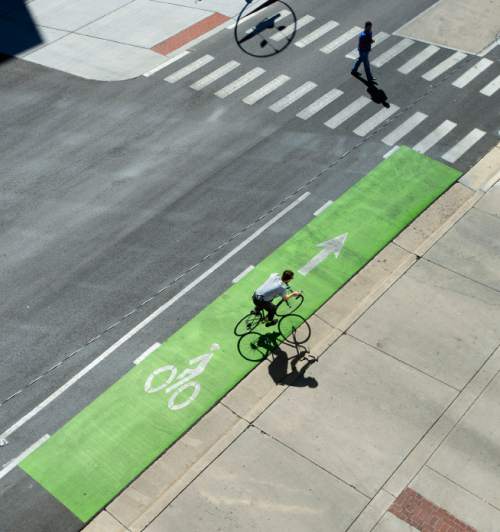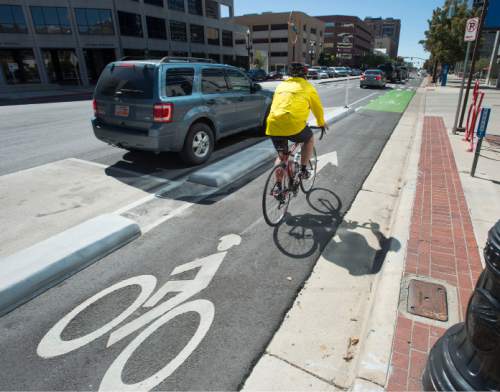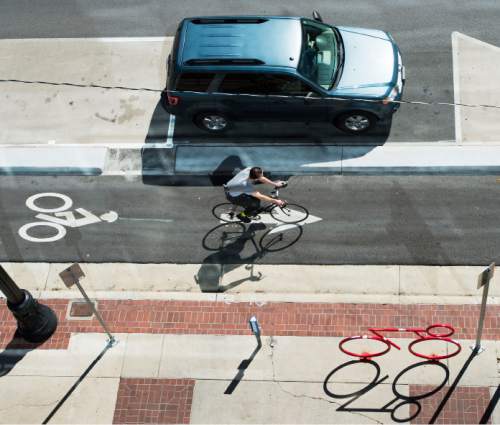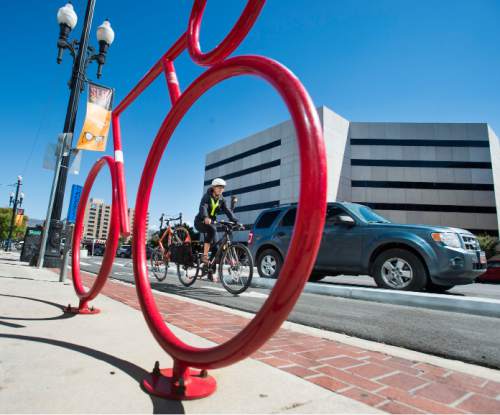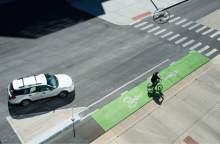This is an archived article that was published on sltrib.com in 2015, and information in the article may be outdated. It is provided only for personal research purposes and may not be reprinted.
Broadway — or 300 South — in downtown Salt Lake City has a new vibrancy, no doubt.
But how much of that new life is due to protected bike lanes installed last year is a matter of debate for some business owners.
A new progress report from City Hall, however, touts the $900,000 bike-lane project as an unqualified success.
It shows that sales-tax receipts along the route from 600 East to 300 West are up an impressive 8.75 percent when comparing the first six months of 2013 (before construction) with the first six months of 2015 (after completion).
The raw sales-tax data were supplied to the city Finance Department by the Utah Tax Commission, said commission spokesman Charlie Roberts. Those numbers then were analyzed by location, said Robin Hutcheson, city transportation director.
When comparing those same periods, overall sales-tax receipts were up 7 percent across Salt Lake City.
The progress report also reveals that bicycle traffic along the route rose about 30 percent after the protected bike lanes were installed.
Similar increases have been seen across the country when such bike lanes become available, Hutcheson said.
She noted, however, that the new dynamic of 300 South may also be due to street medians, planters and public art that add to the pedestrian experience.
John Mueller, the owner of Paradise Palm, 307 E. Broadway, said his business shot up when the automobile speed limit was reduced to 20 mph as part of the bike project.
"When the 20 mph sign went up," he said, "our business increased 20 percent, just like that."
He chalks it up to motorists having time to check out his storefront.
Mueller added that not many bicyclists stop in to buy plants.
Many drivers still remain confused about the parking system along 300 South, Mueller added. "If they ever figure that out, we'll have even more customers."
Down the street, at Maeberry Vintage clothing, 215 E. Broadway, Rachael Skidmore agrees that the street is lively.
"But I don't know if business is up because of the bike lanes. How would you know that?" she asked. "To say that has improved business is a little bit bold."
With time, Skidmore said the protected bike lanes and attendant parking scheme would be an improvement. But thus far, not all motorists or cyclists have figured out the new design.
"We still have people riding on the sidewalks," she said. "And I got an Instagram from someone in Farmington saying she wanted to shop here but couldn't figure out the parking."
Ron Green, the proprietor of The Green Ant, 179 E. Broadway, which sells mid-century modern furniture, says his business is up, too. But he believes it's due to a rebounding economy and more people moving into the city, rather than the addition of protected bike lanes.
Beyond that, the new scheme provided a challenge, he said, because it removed a third of the parking spaces in front of his business.
"Sales tax may be up, but the bike lanes had absolutely nothing to do with it," he said. "That's my opinion."
Green and Mueller both were quoted in the city report, and the comments included were all positive. They did not accurately reflect their mixed feelings about some aspects of the project, they said.
According to the 300 South progress report, 59 percent of businesses along the route are "supportive" or "very supportive" of the project. The report said that 23 percent were "neutral" and 18 percent were "unsupportive."
The city is in the process of connecting the east-west protected bike lanes on 300 South to protected north-south lanes on 200 West that will run from North Temple to 900 South.



